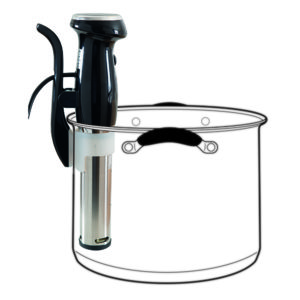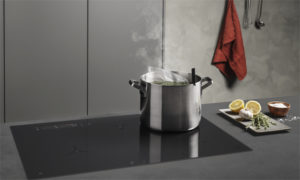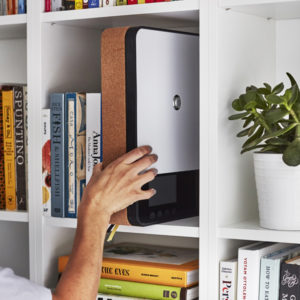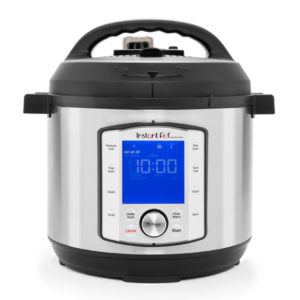KITCHEN TECH IS CHANGING HOW WE COOK
Over the past decade there’s been a revolution in smart tech in our homes. From TVs that stream the latest on-demand hit series to voice-assistant controlled wireless speakers and doorbells that enable you to communicate with a delivery driver from the other side of the world, it’s hard to imagine life without them.
Yet the average kitchen has remained remarkably unchanged: an oven that’s barely more than a metal box with a heated electrical element, a gas or electric hob with number dials offering little in the way of temperature precision, and (if you’re lucky) a microwave that went mainstream in 1967! When it comes to kitchen tech, it seems we’re firmly stuck in the mid-20th century.
However, things are about to get exciting in the kitchen. Popular cookery programmes, such as Masterchef and Great British Menu, have opened viewers’ eyes to different methods of cooking and have sparked an appetite for adventure. And now, thanks to an array of innovative smart kitchen technology hitting the marketplace, culinary techniques and dishes that were once the preserve of professional chefs and food geeks are set to become more widespread over the next few years.

The ambitious domestic chef
It’s possibly no surprise that during the last year we have seen people become more adventurous in their cooking. With lockdown meaning restaurants closed, home cooks have been experimenting with new techniques and recipes in an effort to create the same level of culinary excellence they enjoy when eating out, and to relieve some of the boredom of lockdown. The popularity of specialised food kits and delivery boxes has surged in the last 12 months and the sale of cookware was up by 40% in 2020 from the previous year. It seems domestic chefs have gained confidence and are looking to expand their repertoire in the kitchen.
A move to sous-vide
If there’s one cooking technique that’s empowering adventurous home cooks to achieve the quality of dishes at home that were traditionally the preserve of professional kitchens it’s sous-vide, the process of vacuum-sealing ingredients in a bag, then cooking at a precise temperature in a water bath.
 Until the launch of the Anova Precision Cooker in 2014, sous-vide cookers were bulky and expensive. However, Anova’s sleek, easy-to-use wand-like immersion cooker brought sous-vide to the mainstream and has started a boom that is spreading. Other technology companies are following suit, such as iVide with their 2.0 Sous Vide Cooker and Lakeland with their own-brand Sous Vide Wand.
Until the launch of the Anova Precision Cooker in 2014, sous-vide cookers were bulky and expensive. However, Anova’s sleek, easy-to-use wand-like immersion cooker brought sous-vide to the mainstream and has started a boom that is spreading. Other technology companies are following suit, such as iVide with their 2.0 Sous Vide Cooker and Lakeland with their own-brand Sous Vide Wand.
Due to the fact the products are sealed away from the water and cooked at low temperatures, the nutritional content of the ingredients is preserved. This technique of cooking goes hand in hand with the shift we are seeing towards healthier, fresher cooking, also evidenced in the success of air fryers that use a fan mechanism to create the crisp effect of deep-fat frying but with a fraction of the oil.
Professional consistency
A key driver of innovation in kitchen smart tech is the desire for more accuracy and consistency amongst the growing ranks of adventurous home cooks. The average kitchen has so many variables at play – hobs with clumsy power dials, pans made in various materials and thicknesses, ovens that take an age to reach temperature – that there is often a fine line between culinary success and a burnt failure.

Kitchen equipment manufacturers recognise the demand for precision. AEG has recently released its most advanced hob: the SensePro Induction Hob. Marketed as ‘the personal sous chef for restaurant-style results at home’, the hob includes a wireless food sensor that measures the core temperature of food and communicates adjustments to the hob, so that the user can sear vegetables, cook pasta or simmer a sauce in complete confidence. The only downside is the cost, with models starting at a hefty £1,400.
The smaller kitchen
As kitchens and living space gets smaller, and house-shares become more common, kitchen gadgets that take up very little space and can be packed away will be of increasing importance. But that doesn’t mean we should have to skimp on features. Home chefs still want consistency, the ability to cook sous vide, and smart sensors and probes to ensure the food is cooked ‘just right’– even if the cooking has to take place in a small space. So, we’re just starting to see new technology that has all these bases covered; small, smart, sensors and probes for consistency, and then easily packed away and stored once you’ve finished.
The Njori Tempo is a good example of this move to smart and small. It offers the precision necessary to craft restaurant-standard dishes at home in a small pack-away design that can be stored on a standard bookshelf.

The Njori Tempo packs a huge amount of culinary tech, including a feedback loop that enables the user to set and maintain a precise temperature for sous-vide, deep-frying, shallow-frying or slow-cooking; integrated scales for weighing ingredients before and during cooking, as well as enabling users to reduce by a specific weight; an assortment of probes to test the temperature of the food itself; and an ergonomic, magnetic dial to make delicate temperature adjustments that influence the food temperature, rather than the cooking temperature.
Multi-functional equals mass-market appeal
If affordability is the greatest barrier to entry for most domestic chefs, then multi-functional products could be the game-changers transforming the quality of home-cooked meals over the coming years. Most are keenly priced, pack a lot of features into a small footprint.
The undisputed market leader of multi-functional products right now is the Instant Pot, which combines an electric pressure cooker, rice cooker, sauté pan and yoghurt maker in one handy unit that costs less than £100. Dishes that usually require several hours in the oven, such as slow-cooked pulled-pork, can be achieved without fuss, in a fraction of the time. It also consumes far less energy than a traditional oven.

Created by four former colleagues in Canada, the Instant Pot’s success is in part down to the designers’ attention to detail and quick reaction to customer feedback which has helped the smart cooker achieve something of a cult following across the world. Thanks to its community of websites, food bloggers who champion recipes, and books dedicated to exploring exciting new dishes to cook with the Instant Pot, the popularity of this multi-functional tool is only likely to grow.
Grand designs for the future
The revolution in smart home tech may have largely evaded the kitchen until now. But as technology brings new possibilities and, as home cooks, we become ever more adventurous, our culinary future is an exciting one. As technology becomes more ingrained in our kitchens, the realms of possibility will be extended even further. These technologies will make perfect cooking a breeze for the home cook, with precise control over time and temperature, whatever the task at hand. Connected devices and appliances will be able to communicate with each other ensuring meals are created and timed in perfect harmony.
We will also start to see more influence from companies developing AI and machine learning, creating devices with smart features that will be able to learn our cooking habits and remember our favourite meals and how we like to cook them. They will also become simpler in order to make our lives easier, enabling us to become more time efficient and less prone to basic cooking errors.
This adaptation to human behavior is already present in the form of products like the Electrolux Inspiro oven, which calculates the precise combination of energy consumption and time needed to bring your food to the correct temperature. All at the push of a button.
Granted it will take time for these technologies to filter from the top end products through to the mainstream but as the technology becomes more widespread, these features will become the norm. The high-end products will then be reserved for those wanting to create the ultimate gastronomic experience. The truly adventurous home chef.
One thing I think that will help push these technologies through quicker is the push to reduce our environmental impact. Smart grid technology, already being developed in a number of European countries will help to improve energy efficiency and reduce carbon emissions. Achieved by avoiding peak period demand and decreasing reliance on emission-creating backup power options, it can also provide anything from remote diagnoses, software updates or the latest recipes from your favourite chefs.
With cities and the populations within them growing, these smart grids will be ideal for the fast pace and adaptability required by most urban populations. Here, products need to be efficient in both size and performance. We expect to see products like the Tempo, pave the way for this new technology – small, functional and with the accuracy to transform your cooking.
ABOUT THE AUTHOR
 Nick Orme, co-founder of Njori. Njori designs smart, innovative kitchen tech for foodies who want professional, restaurant quality results at home. The Njori Tempo is the first pack-away smart induction cooker that enables you to measure, monitor and regulate temperature to compose perfect meals, every time.
Nick Orme, co-founder of Njori. Njori designs smart, innovative kitchen tech for foodies who want professional, restaurant quality results at home. The Njori Tempo is the first pack-away smart induction cooker that enables you to measure, monitor and regulate temperature to compose perfect meals, every time.
Web: njori.com
Instagram: @njoricooking
LinkedIn: njori-ltd

